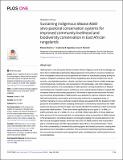| dc.description.abstract | Alalili system is one among the fewest remnant African indigenous and local knowledge systems that is traditionally practiced by Maasai pastoral communities to conserve certain portions of rangeland resources such as pastures and water for subsequent grazing during dry seasons. Despite its existence, East African rangelands face diverse threats from tenure security, unsustainable practices, climate, and land-use change that are notably endangering the biodiversity, livelihoods, and ecosystems in the landscape. Like other indigenous conservation systems, the sustainability of Alalili systems is being threatened, as Maasai communities are in transition due to continuous socio-cultural transformations coupled with increased livestock and human populations. We aimed to capture and document the existing occurrence and potential of Alalili systems as a pathway to improve resilience and sustain both biodiversity conservation and community livelihoods in rangeland areas of northern Tanzania. A cross-sectional research design was applied with the adoption of both purposive and stratified random sampling techniques to distinctively characterize the Alalili systems by land use and tenure types. Our results identified the existence of both communal and private Alalili systems. Their sizes varied significantly across types (t = 4.4646, p < 0.001) and land uses (F = 3.806, df = 3, p = 0.0123). While many (82%) of these Alalili systems are found in the communal land, our observations show a re-practice of Alalili systems in the private land is considered largely a re-emerging strategy for securing pastures in the face of local and global change. More than half (73%) of Alalili systems were found within game-controlled areas with little representation (about 8%) in non-protected land. Therefore, their sustainability is threatened by anthropogenic and climatic pressures, making their persistence more vulnerable to extinction. We recommend mainstreaming these practices into core pasture production and management areas, facilitating their reinforcement into policy and practices. | en_US |

